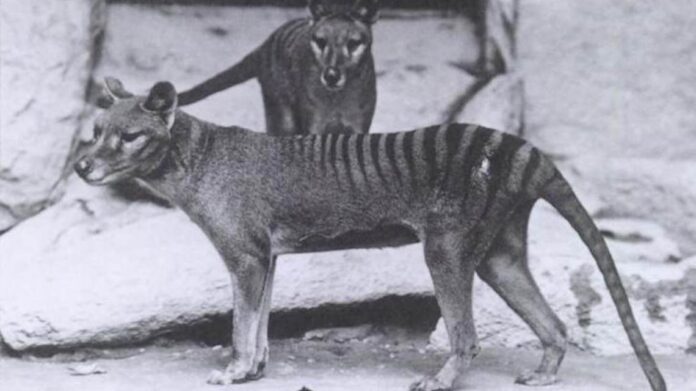The Tasmanian tiger, long believed to have gone extinct in 1930s, may have survived for several more decades and may even still exist in the Australian wilderness, according to new research. These carnivorous marsupials, also called thylacines, are notable for the stripes on their backs and their wolf-like appearance.
The Backstory On The Tiger
Tasmanian tigers lived on mainland Australia until 3,000 years ago when humans culled their population. The last surviving thylacines lived on Tasmania until they were hunted by European settlers in the 19th century, according to Live Science. A lack of genetic diversity may have also contributed to their demise. The last known living Tasmanian Tiger died in Tasmania at the Hobart Zoo in 1936.

Thylacinus at Hobart Zoo. Via Wikimedia Commons.
Some researchers, however, believe the marsupial apex predator likely lived in the wild until the 1980s or 1990s, and there is a small possibility that some are still alive today in part of the state’s southwestern region. Scientists believe the earliest date of extinction was the mid-1950s. They came to this conclusion after analyzing data from 1,237 thylacine sightings in Tasmania as far back as 1910. The study was published in the journal Science of The Total Environment.
What Researchers Have Found
Barry Brook, a professor of environmental sustainability at the University of Tasmania and lead author of the study, told The Australian, “We used a novel approach to map the geographical pattern of its decline across Tasmania and to estimate its extinction date after taking account of the many uncertainties.”
Not everyone believes thylacines survived that long or are still roaming Tasmania. Andrew Pask, a professor of epigenetics at the University of Melbourne in Australia leads the Thylacine Integrated Genomic Restoration Research (TIGRR) Lab, whose purpose is to use gene-editing to resurrect the Tasmanian tiger. Pask, who was not involved in the latest research, told Live Science that the sightings are not backed by evidence and pointed out that someone would have found a dead thylacine at some point over the years.

Thylacinus at Hobart Zoo. Via Wikimedia Commons.
“One thing that’s so interesting about the thylacine is how it evolved to look so much like a wolf and so different to other marsupials,” he explained. “Because of this, it is very hard to tell the difference at distance between a thylacine and [a] dog and this is likely why we still continue to have so many sightings despite never finding a dead animal or unequivocal picture.”
While it is possible that some Tasmanian tigers may have lived in the wild around 1936, “if there were survivors, there were very few,” Pask commented. Since the extinction occurred not too long ago, his group has DNA samples that could aid in reviving the species. His justification for bringing them back from the dead is that their extinction was due to human interference, and the ecosystem in which they lived is still in place.
“The thylacine would certainly help rebalance the ecosystem in Tasmania,” Pask said. “In addition, the key technologies and resources created in the thylacine de-extinction project will be critical right now to help preserve and conserve our extant endangered and threatened marsupial species.”
An Uncertain Future
Not everyone supports initiatives that aim to reintroduce extinct species into the ecosystem. Corey Bradshaw, a professor of global ecology at Flinders University, told The Conversation that Pask’s project could prevent newer extinctions and a revived thylacine population would struggle to survive due to a lack of genetic diversity.
In 2022, the remains of the last-known Tasmanian tiger were found after being missing for more than 85 years. The thylacine only survived a few months in captivity at the Hobart Zoo until its death in 1936, and its body was given to the Tasmanian Museum and Art Gallery (TMAG) where it was stored for decades until it was properly identified.
By Noelle Talmon, contributor for Ripleys.com
EXPLORE THE ODD IN PERSON!
Visits: 0












